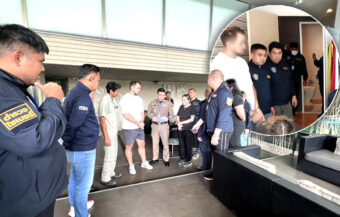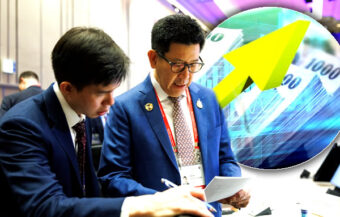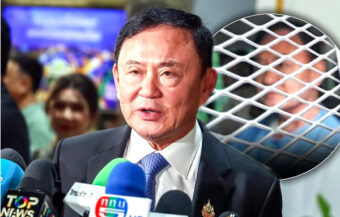Thailand’s economy posts tentative recovery with a 2.3% growth target, fueled by export surge, but faltering tourism, rising bad loans, high household debt and structural issues pose serious risks to sustained growth and financial stability. However, there is a new plan.
Figures released Monday by the NESDC show Thailand’s economy growing in Q2, yet Finance Minister Pichai Chunhavajira aims for 2.3% growth this year, fueled by a rush of exports. The government is also revising the poverty line ahead of the 2027 negative income tax plan; the 2023 benchmark is ฿3,043 per month. Secretary-General Danucha Pichayanan warns structural issues will take years to fix, keeping consistent 3% growth out of reach. Meanwhile, the banks face rising danger from bad loans, with mid- and large-scale firms increasingly missing payments.

Thailand’s recovery is real, but still uneven. Growth is back, yet too many weaknesses persist beneath the surface. The economy expanded by 2.8% in the second quarter of 2025, beating most forecasts. This improvement was driven largely by exports, particularly to the US. American importers have rushed orders ahead of the new tariff hikes under the Trump reciprocal tariff regime. This surge helped Thailand’s shipments outperform expectations.
Still, the 2.8% GDP figure is slower than the 3.2% seen in the first quarter. For the first half of the year, growth averaged 3%. The momentum is welcome, but fragile.
Exports drive recovery while domestic demand lags and foreign tourism struggles to meet expectations
Exports remain the backbone. While they’ve carried the economy, domestic demand has struggled to catch up. Household spending is softening. Consumer sentiment is fickle. High debt levels are limiting new borrowing. In parallel, the government’s own spending has been sluggish, hindered by delays in budget disbursement.
Meanwhile, tourism remains far below potential. Foreign arrivals are underperforming expectations, especially from China. The government has already cut its annual tourism target from 37 million to 33 million visitors. This shortfall is weighing heavily on hospitality and related sectors.
To support the recovery, the Bank of Thailand delivered its first rate cut in years. The 25-basis-point reduction came despite criticism from some quarters. Policymakers hope this move will spur consumption, ease debt burdens and stimulate private investment.
At the same time, Thailand’s economic planning agency, the National Economic and Social Development Council (NESDC), has slightly raised its growth forecast. It now expects GDP to expand between 1.8% and 2.3% this year. Previously, the midpoint stood at 1.8%; now it’s been nudged up to 2%. Although modest, the revision suggests cautious optimism.
Agriculture gains and services expand while investment improves amid persistent credit vulnerabilities
Sector by sector, the picture is mixed. Agriculture grew strongly, up 6%, with fruits, rice and fisheries performing well. Yet output of cassava, rubber and sugarcane declined. Outside agriculture, services, trade and manufacturing expanded by 2.5%. However, the accommodation and food services industry is still suffering from low tourist flows.
Private investment finally turned positive after five quarters of contraction. It rose 4.1%, driven by machinery and equipment. Overall investment jumped 5.8%, reflecting growing confidence in certain industries. Public investment also grew, climbing 5.2% despite delays in project rollout.
On a quarterly basis, the economy expanded 0.6% after seasonal adjustments. This was slightly below the 0.7% growth in Q1 but still signals resilience.
Nevertheless, serious vulnerabilities persist, especially in credit. Debt stress is rising, not just among SMEs but also in mid-sized and larger firms. According to Kasikorn Research Centre, four sectors are now under intense pressure: manufacturing, retail, construction and hospitality.
Hospitality sector faces rising bad loans and larger borrowers are now increasingly at serious risk
Hospitality, in particular, is deteriorating rapidly. Special mention loans—those overdue between 30 and 90 days—have climbed to 2.23% of outstanding credit. Non-performing loans in the sector have reached 3.95%. Worryingly, larger borrowers—those with loans over ฿500 million —are starting to miss payments.
This could pose risks to the broader financial system. K-Research is calling for urgent action. It recommends rapid debt restructuring and cuts to asset transfer fees. Without these measures, more businesses may tip into default.
In response to widening inequality, the government is preparing to launch a bold new policy. By 2027, Thailand plans to implement a negative income tax. This will offer direct cash transfers to low-income households. The poverty line, currently set at ฿3,043 per person per month, is under review.
The scheme will require all citizens to file tax returns. This marks a significant overhaul of Thailand’s welfare and taxation systems. It also signals a shift toward more targeted and transparent fiscal policy.
Structural reform and high-value sector investment are crucial for sustainable growth in the years ahead
Still, broader reform is needed. NESDC chief Danucha Pichayanan says Thailand may not reach consistent growth above 3% for another two to three years. In his view, structural issues are holding the country back.
To break free from stagnation, Thailand must transform its economy. The low-cost export model is outdated. Future growth depends on high-value sectors like electric vehicles, aerospace, digital industries and medical devices. This transformation will require serious investment in automation, skills development and infrastructure.
Finance Minister Pichai Chunhavajira agrees—but remains cautiously optimistic. He expects GDP growth to top 2% this year if bottlenecks are resolved. The recently approved ฿3.78-trillion budget is a key part of that effort. It is designed to boost consumption and fund strategic projects.
At the same time, trade tensions remain a concern. For now, Thailand’s exporters are protected by the 19% rate—but only if their products meet strict origin requirements. That’s a narrow safety net and still represesnts an added cost for US importers.
Political and regional risks remain high while debt while tepid consumption and domestic challenges persist
Political instability is also a growing risk. The sudden suspension of Prime Minister Paetongtarn Shinawatra has rattled investor confidence. Meanwhile, border tensions with Cambodia are escalating. These developments could unsettle financial markets and delay reforms.
Another major drag is debt. Household and corporate leverage remain stubbornly high. Credit access is tightening, especially for borrowers in weaker sectors. This is holding back both consumption and private sector expansion.
On the positive side, inflation remains low. Consumer prices are expected to rise just 0.3% this year. That gives the central bank room to ease further if needed. The baht has also stabilised, trading between 32.5 and 33.5 per dollar. Currency volatility is no longer a major concern.
Yet tourism still lacks momentum. Revenues could reach ฿1.57 trillion this year, but the volume of arrivals remains disappointing. Officials are banking on relaxed visa rules and aggressive marketing campaigns. Whether those efforts will succeed remains to be seen.
Exports and manufacturing now carry the economy while policy execution will determine recovery
Exports and manufacturing are now doing the heavy lifting. The NESDC expects exports to grow by 5.5% this year. Strong demand from major partners is helping offset weakness in domestic sectors. Still, it may not be enough to deliver a broad-based recovery.
The agency has outlined four priorities: shield exporters from external shocks, support distressed SMEs, speed up tourism recovery and accelerate fiscal disbursement. Execution will be critical. Delay or missteps could reverse tentative gains.
Thumbs up from economic gurus for 2027 Negative Income Tax plan. It’s a game-changer for progress
Huge economic change as Reverse Tax plan is being pushed by the Pheu Thai government as it battles on
Thailand’s economy is growing again, but unevenly. Without deeper reforms and stronger policy coordination, it risks falling back into stagnation. The next 12 to 24 months are critical. Thailand faces a narrow window—either to reset its growth model or fall further behind.
Join the Thai News forum, follow Thai Examiner on Facebook here
Receive all our stories as they come out on Telegram here
Follow Thai Examiner here
Further reading:
Thumbs up from economic gurus for 2027 Negative Income Tax plan. It’s a game-changer for progress
Expert warns foreign tourism has become Thailand’s curse, fueling inertia and a widespread malaise
Thaksin does not rule out joining talks in US as Thai team finalises plans. They fly out on Thursday


















